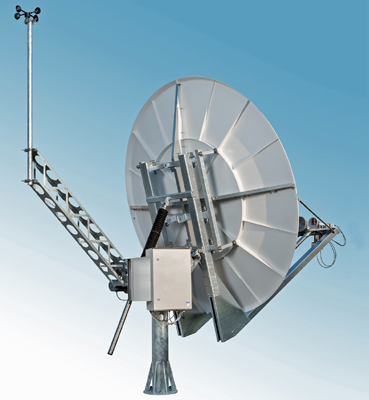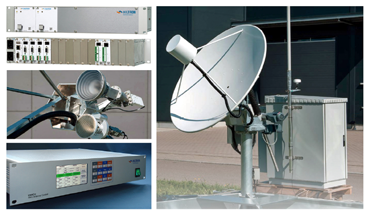The claim has been made that, in broadcasting, nobody dies if a device or system fails.

Figure 1.
With military applications, the opposite is obviously true. In reality, broadcast infrastructure designers go to great lengths to ensure reliability by ensuring no single point of failure exists in the vital components of any system, encouraging news for those engaged in MILSATCOM, as well.
Naval Fleet Data &Voice Comms Systems
In the military communications sector, Hiltron recently announced the completion of data and voice communication systems for one of the largest naval fleets in the NATO Maritime Group. The project was carried out in partnership with a major European company which specializes in naval electronics.
This was the latest project in a series with this particular partner, which has been ongoing on a ship by ship basis since 2011. Each installation provides the codec facilities needed for secure satellite-based communication between vessel and land, including IP network access and vocal telephony. The previous systems have proven to be highly reliable and are based on Vocality codecs, which are among the most efficient of their kind currently available.
Ship to shore communication is a vital aspect of naval operations and far easier to achieve using satellite links than traditional radio technology. Vocality multiplexers provide the full range of user-facing connectivity, while managing the bandwidth used in multiplexing the services between locations.
Four variations are available: portable V25 and V50plus and rackmount V150 and V200. Each voice and data multiplex offers a different layout and density of ports such as voice, Ethernet, serial data or ISDN. As they all operate the same software, their management interface is nearly identical and they are all interoperable.
Aerospace Satellite Tracking System
Another recently completed project was the installation of a global satellite tracking system for one of the world's largest aerospace companies. The system included six Hiltron HMAM motorized satellite antenna mounts integrated with a Hiltron HACU antenna control unit and associated motor-control electronics.
HMAM is a high-precision motorized satellite antenna mount designed for two-way VSAT communication or receive-only downlink applications. This mount can be used for a wide range of applications that include broadcast and telecommunication downlinks.
An optional motorized feed changer allows the head to be moved quickly to a new position for switching between frequency bands. HMAM comes complete with professional-grade drives for azimuth and elevation plus a high-accuracy polarization drive.
The combined head and drive form a three-axis motorized mount with 180 degrees of azimuth adjustment, 90 degrees of elevation adjustment range and fully adjustable polarization.
Each of the six installations in the global satellite tracking system is configured to operate in main-plus-backup roles. Two are located at ground stations in the southern hemisphere, two in Europe and two in North America.
Each HMAM mount supports a 2.4 meter dish (see Figure 1) and is fitted with a wind sensor which activates a safety lock if wind speed exceeds 80 km per hour. The system is being used in a variety of modes to ensure continuity of the client's satellite network.
SORBAS
This global tracking system project is the latest in a long series of successful HMAM installations. HMAM forms the core element of Hiltron’s SORBAS satcom product family (see Figure 2 on the next page) that is designed to form the heart of customized SATCOM systems. These also include Hiltron's HMCS monitoring and control software, HCS universal control unit, HSACU satellite antenna control unit and HDCU de-icing control unit.
Central to the SORBAS product family is the HCS-Core, which is used as a control element for tasks such as switching downconverters, integrated receiver/decoders, digital video broadcast encoders, high-power amplifiers and waveguides. The other products in the series are field-proven and in successful operation at many locations around the world, forming elements of our own systems and those designed by systems integration partners in many countries.
The HCS-Core element of SORBAS is available in 2U high full-rack-width and half-rack-width versions. The full-rack-width model can accommodate up to 16 modules and is Hiltron's largest and most versatile satcom controller to date.
The current range of cards includes a monitor, control and power supply for fiber optic devices, a fiber-optic switch, LNB redundancy systems for C- and Ku-band, HPA redundancy control, redundancy for DVB MPEG encoders/modulators/IRDs and a generic monitoring and control module.
The Hiltron HACU is designed to control three-axis motorized antennas. The antenna control unit and associated motor-control electronics are contained in an IP65-rated weatherproof outdoor housing with a hinged front access port secured by dual key screws.
The HACU can be operated from a PC running a graphic user interface compatible with standard web browsers. The control GUI displays all the information required to set and maintain azimuth, elevation and polarization, including current and target positions plus a database of potential accessible satellites.

Figure 2.
The Hiltron HDCU-E is a combined ice-sensing and dish heating controller for use with large satellite antennas. It is capable of handling up to 450 kilowatts of power across multiple heating groups. Each group is divided into three independently-controlled heater arrays. Each array in turn feeds up to three antenna heater circuits.
A four-group configuration, for example, allows control of 12 arrays addressing a total of 36 heating circuits. This modular control approach permits easy configuration of parameters such as antenna size, number of heater pads and the power requirement of each pad.
Snow detection is via a reflective sensor with a polarizing filter. Each heater circuit is individually supervised and controlled via user-adjustable minimum and maximum thresholds. Sequential switch-on is performed within the controller to prevent rapid changes in current load when the antenna heating process is activated or deactivated. Sequence timing is user-configurable.
Transatlantic Broadcast Link
Long-range links are, of course, a natural application of satellite communication technology, whether for defense or civil applications. Recently initiated is a satellite link that will be used to carry broadcast television content from South America to viewers in Europe. The new system will be located in one of the Baltic states and needed to be live by the end of June in time for the 2016 Summer Games in Rio de Janeiro.
The new link will be a complete turnkey solution with five active channels and is designed to operate as a complete backup system, which can be switched into action if the primary feed fails. Initial planning was completed in partnership with one of the world's largest satellite fleet operators. A site survey was conducted earlier this year.
Assembly subsequently took place at Hiltron's headquarters in Backnang prior to factory acceptance tests, followed in turn by on-site integration, commissioning and acceptance.
hiltron.de/

After graduating with a university degree in economics, Jan Molter served for 14 years as an officer with the German Navy, latterly as Commanding Officer of the submarine U15. He joined FS Antennentechnik GmbH in 2006 as Head of Economics, progressing in 2008 to Schott AG where he served for over five years as Vice President. He was appointed Managing Director of Hiltron GmbH in September 1 2014.
Hiltron GmbH is Germany's leading integrator of satellite and wireless communication systems. They provide turnkey systems of any required scale for customers world-wide. They are part of the Danmon Group, one of Europe's leading suppliers of audio, video, transmission products and digital media solutions. Hiltron operates from modern purpose-built headquarters at Backnang near Stuttgart. On-site facilities include a large technical operations area with high access doors and ceiling, capable of accommodating satellite link vehicles and their roof-mounted antennas.
Although the majority of Hiltron’s products and systems are designed for broadcast rather than military fields, they conform to the high standards of performance and reliability demanded in both areas of operation.
The technical solutions offered by Hiltron include compact point-to-point microwave links to ground stations with antennas of 11 meters or more. Also produced are truck-mounted satellite links for applications such as broadcast news gathering plus a range of fiber-optic systems delivering signals to and from SATCOM terminals.
Additional company experience also overlaps into asynchronous transfer mode networking for major broadcasters, such as Bayerischer Rundfunk and Südwestrundfunk. The network adapters are usually equipped with an interface card that enables transmission of the signal via terrestrial microwave links to the transmitter stations. The latter are mostly located as high as possible above neighboring terrain, ideally at the top of mountains.


